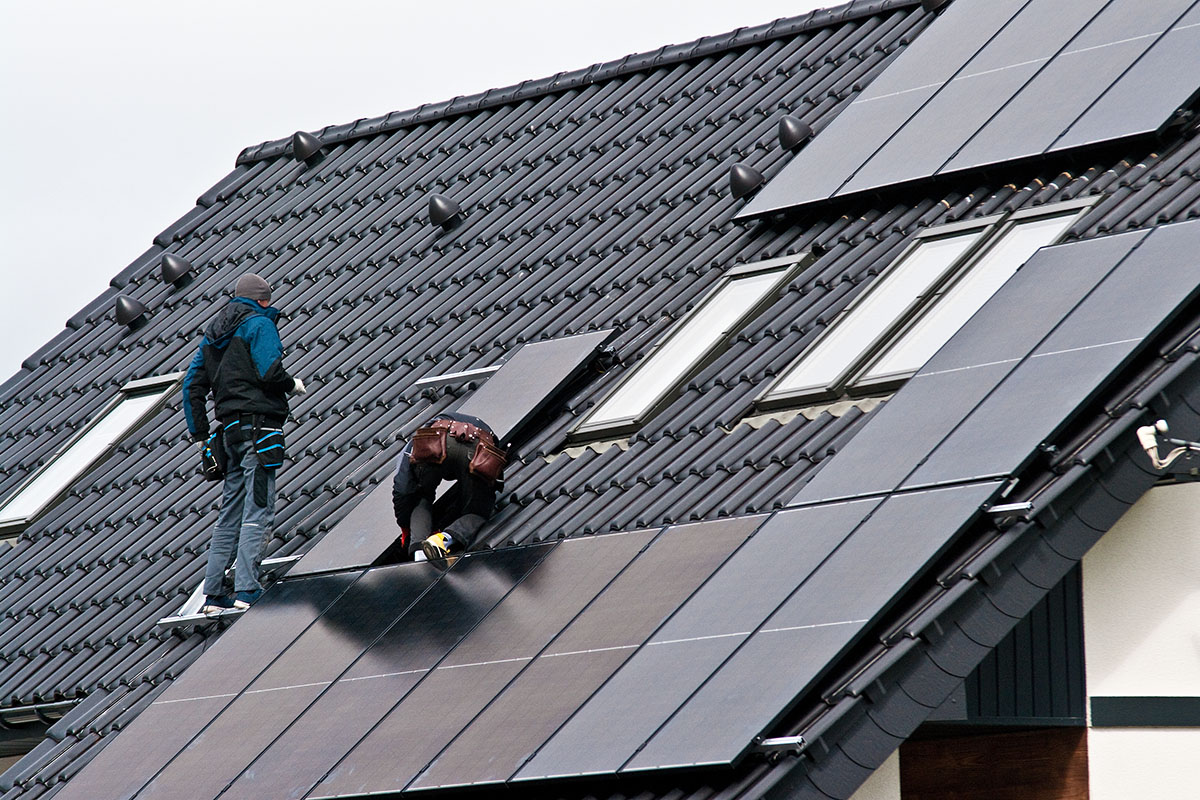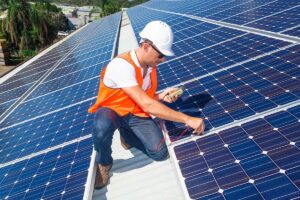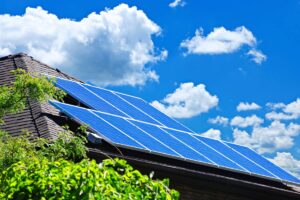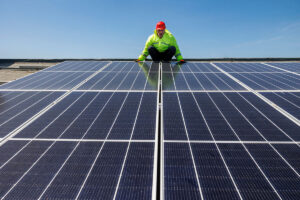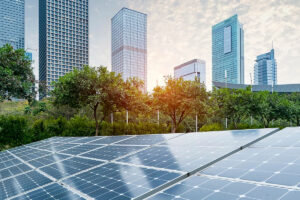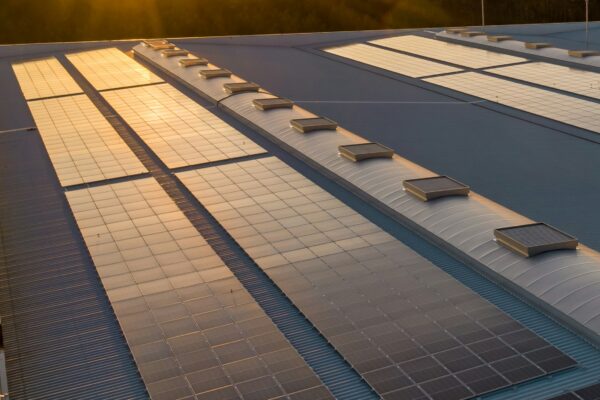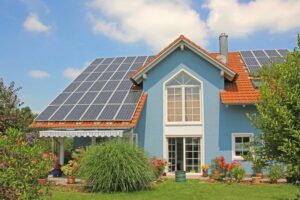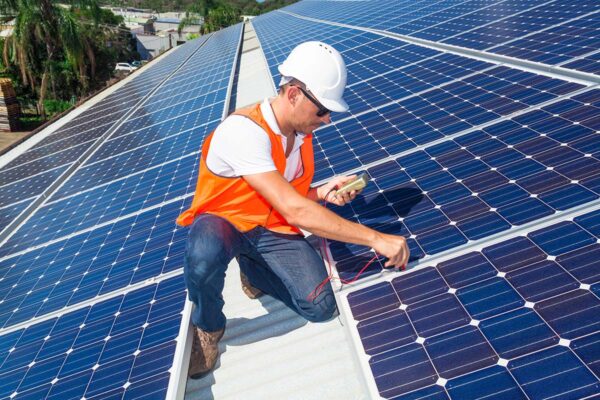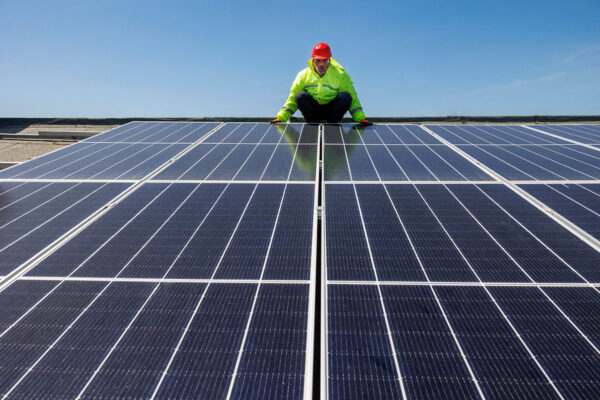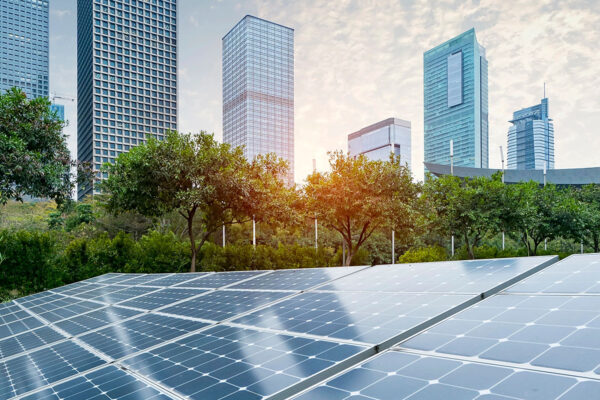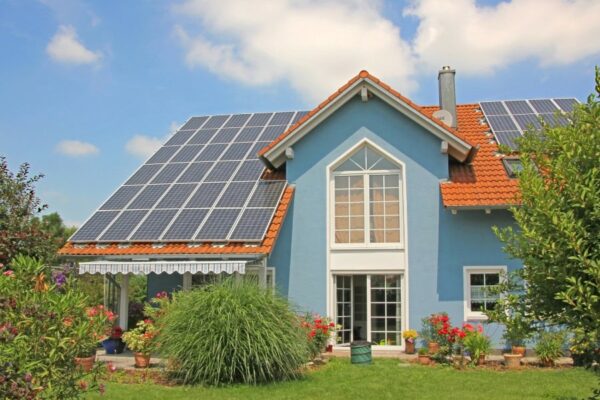Installing solar panels on metal roofs has become a popular choice for homeowners looking to harness sustainable energy. We’ll cover the feasibility and benefits of solar panels on metal roofs, addressing key considerations and advantages.
By considering solar panels for your metal roof, you can:
- Enhance energy efficiency
- Reduce environmental impact
- Potentially save on energy costs in the long run
Whether you are looking to decrease your carbon footprint or maximize the cooling benefits of your metal roof, installing solar panels could be a beneficial investment for your property.
Types of Solar Panels Suitable for Metal Roofs
Metal roofs pair well with several types of solar panels, but the choice depends on factors like roof design, weight capacity, and aesthetic preferences. The two main categories to consider are thin-film solar panels and traditional silicon solar panels.
Thin-Film Solar Panels
Thin-film solar panels are lightweight and flexible, making them ideal for metal roofs. Here are some key features:
- They have a lower profile compared to traditional panels, which helps maintain the sleek appearance of metal roofing.
- Manufacturing thin-film panels requires less energy, contributing to a smaller carbon footprint.
- MiaSolé thin-film solar panels stand out for their durability and efficiency in metal roof installations. Their flexibility allows easier mounting on standing seam and corrugated metal roofs without adding significant weight or bulk.
Traditional Silicon Solar Panels
Traditional silicon solar panels are more rigid and heavier than thin-film options. Here are some key features:
- They offer higher efficiency rates, converting more sunlight into electricity compared to thin-film panels.
- These panels have a longer lifespan and generally come with extended warranties, providing reliable performance over time.
- Monocrystalline and polycrystalline silicon panels are common types used for residential installations because of their proven track record in various environments.
Installing Solar Panels on Metal Roofs
Metal roofs already provide significant cooling benefits due to their reflective surfaces, which bounce sunlight away and reduce heat absorption. When you add solar panels, these benefits increase. The panels shade the roof surface, further lowering rooftop temperatures and cutting cooling costs inside the building. This combination enhances energy efficiency by reducing reliance on air conditioning during hot months.
Environmental advantages of pairing metal roofs with solar panels:
- Eco-friendly roofing materials: Metal roofs are made from recyclable materials and often have a long lifespan of 40 to 70 years, outlasting many other roofing types. Their durability minimizes waste over time.
- Reduced carbon footprint: Solar panels generate clean electricity, offsetting fossil fuel use, and decreasing greenhouse gas emissions.
- Maximized sustainability: Both technologies complement each other—metal roofs reflect sunlight and improve solar panel performance by keeping them cooler, while solar panels reduce overall energy consumption.
This synergy supports green building certifications such as LEED and ENERGY STAR. Choosing metal roofs combined with solar panels positions your property as an energy-efficient, environmentally responsible space that delivers lasting value beyond simple utility savings.
Mounting Options for Solar Panels on Different Types of Metal Roofs
When it comes to mounting solar panels on metal roofs, there are various options to consider depending on the type of metal roof you have. Here are some key points to help you understand the mounting systems for different types of metal roofs:
Overview of Mounting Systems
Different types of metal roofs require specific mounting systems to ensure a secure and efficient installation of solar panels.
Each mounting system is designed to fit the characteristics and structure of the roof, providing stability and longevity to the solar panel setup.
Standing Seam vs Corrugated Metal Roofs for Solar Panels
Standing seam roofs are preferred for solar panel installation due to their raised seams that allow for easy clamping without penetrating the roof surface.
Corrugated roofs, on the other hand, may require drilled holes for mounting, which can affect the integrity of the roof if not done correctly.
Rail-based vs Rail-less Mounting Options
Rail-based mounting systems involve installing horizontal rails on which solar panels are mounted, providing flexibility in panel placement.
Rail-less mounting options offer a sleeker appearance by directly attaching panels to special mounting hardware without the need for rails. This can reduce costs and installation time.
Understanding these differences in mounting options can help you choose the best approach for installing solar panels on your specific type of metal roof.
Installation Process and Considerations for Solar Panels on Metal Roofs
Installing solar panels on metal roofs involves specific steps to ensure durability, safety, and efficiency. The process typically follows this sequence:
- Roof Assessment: Examine the metal roof’s condition and confirm its structural integrity for supporting solar panels. This includes checking for rust, existing damage, and roof age.
- System Design: Plan the layout considering sunlight exposure, shading, and panel orientation to maximize energy output.
- Mounting Selection: Choose appropriate mounting hardware based on roof type—standing seam or corrugated—and decide between rail-based or rail-less systems.
- Panel Installation: Attach mounting brackets using clamps or fasteners. For standing seam roofs, non-penetrating clamps are preferred to avoid roof damage.
- Electrical Wiring: Connect solar panels to inverters and integrate the system with your home’s electrical setup.
- Final Inspection: Verify secure attachment, proper wiring, and compliance with local codes.
Structural Considerations for Solar Panel Installation on Metal Roofs
- Weight Load: Metal roofs are lightweight but strong; however, confirming their load-bearing capacity is crucial since solar panels add weight.
- Wind Resistance: Secure fastening prevents panels from detaching during strong winds. Clamping systems designed for metal roofs enhance wind resistance without compromising roofing integrity.
Non-Penetrating Solar Panel Installs on Metal Roofs
Non-penetrating mounting options eliminate the risk of water leaks by avoiding roof penetration.
- Standing Seam Clamps: Use factory seams to clamp panels securely without drilling holes.
- Ballasted Systems: Utilize weighted mounts that hold panels in place mainly through gravity; more common in flat metal roofs.
These methods preserve the waterproof quality of metal roofs while providing safe, durable solar panel installations.
Maintenance, Cost Factors, Compliance, and Regulations for Solar Panels on Metal Roofs
Maintenance Tips for Solar Panels on Metal Roofs
To maintain longevity and efficiency of your solar panels installed on metal roofs, consider the following maintenance tips:
- Regularly inspect your solar panels for any dirt, debris, or leaves that may obstruct sunlight. Cleaning them periodically will help maximize their energy production.
- Check for any signs of damage or wear on both the solar panels and the metal roof. Addressing any issues promptly can prevent further complications.
- Keep an eye on the inverter, which is responsible for converting the DC electricity generated by the panels into AC electricity for use in your home. If you notice any unusual sounds or lights on the inverter, contact a professional for assistance.
- Schedule professional inspections at least once a year to ensure everything is functioning optimally.
Cost Factors for Installing Solar Panels on Metal Roofs
When considering the installation of solar panels on metal roofs, several cost factors come into play:
- Roof Type: The type of metal roof you have an impact on the installation costs. Some metal roofs may require additional mounting equipment or specific installation techniques, which can increase labor expenses.
- System Size: The size of the solar panel system you choose directly affects the overall cost. Larger systems typically require more panels and equipment, resulting in higher material and installation costs.
- Location: Geographic location plays a role in pricing as well. Areas with higher labor costs or specific permitting requirements may result in increased expenses.
Permitting and Code Requirements
Before installing solar panels on your metal roof, it’s crucial to understand the permitting and code requirements specific to your area. Local building codes can affect various aspects of the installation process, including:
- Structural Integrity: Building codes may mandate that your roof structure can support the additional weight of solar panels. An engineer’s assessment might be necessary to ensure compliance.
- Setback Regulations: Some jurisdictions have setback regulations that dictate how far back from property lines or neighboring structures solar panels must be installed. Understanding these requirements is essential for proper placement.
- Electrical Standards: Local electrical codes will govern how electrical connections are made between the solar panel system and your home’s power supply. Compliance with these standards is critical for safety.
By familiarizing yourself with these permitting and code requirements, you can avoid potential delays or complications during the installation process.
How Local Building Codes Affect Solar Panel Installation
Local building codes have a significant impact on solar panel installations, including those on metal roofs. Here’s how they can influence the process:
- Design Restrictions: Building codes may impose design restrictions that dictate how solar panels should be integrated into your existing structure. This could include guidelines on color choices or architectural features to maintain aesthetic harmony.
- Installation Techniques: Certain building codes might specify specific installation techniques or materials that must be used when attaching solar panels to metal roofs. Adhering to these requirements ensures compliance and prevents issues down the line.
- Inspection Processes: Local building authorities often require inspections at various stages of construction projects, including solar panel installations. Understanding these inspection processes helps you plan accordingly and avoid potential setbacks.
Built to Support Solar, Built to Last
If you’re asking, “Can I install solar panels on my metal roof?” The answer is a confident yes. Metal roofs offer an excellent foundation for solar energy systems due to their durability, longevity, and compatibility with various mounting options. You benefit from:
- Non-penetrating clamp mounts on standing seam metal roofs that protect your roof’s integrity.
- The synergy of reflective metal roofing and solar panels maximizes energy efficiency and cooling.
- Long-term savings and sustainability by reducing your carbon footprint.
Choosing the right panel type and understanding your roof’s structure guarantees a smooth installation process. Maintenance remains straightforward, while compliance with local codes maintains reliability and safety.
Metal roofs paired with solar panels represent a smart, eco-friendly investment that enhances your home’s value and energy independence. Take the next step by consulting experienced installers who specialize in metal roof solar systems to unlock these benefits for your home.
Frequently Asked Questions About Metal and Solar Roofing
Can I install solar panels on my metal roof?
Yes, you can install solar panels on your metal roof. Metal roofs are highly compatible with various types of solar panels, making them an excellent choice for energy efficiency and sustainability.
What types of solar panels are suitable for metal roofs?
Thin-film solar panels, such as MiaSolé thin-film panels, and traditional silicon solar panels are suitable for metal roofs. Thin-film panels offer benefits like flexibility and lightweight installation compared to silicon panels.
What are the benefits of installing solar panels on metal roofs?
Installing solar panels on metal roofs maximizes cooling benefits and energy efficiency, while also providing environmental advantages due to the eco-friendly nature of metal roofing materials combined with renewable energy generation.
What mounting options are available for solar panels on different types of metal roofs?
Mounting systems vary based on the metal roof type. For standing seam metal roofs, rail-less mounting options are common, whereas corrugated metal roofs often use rail-based mounting systems. Both options ensure secure installation tailored to roof design.
What should I consider during the installation process of solar panels on my metal roof?
Consider structural factors such as weight load capacity and wind resistance when installing solar panels on a metal roof. Non-penetrating installation methods can be used to prevent roof damage during the setup process.
How do maintenance, cost factors, and regulations affect solar panel installation on metal roofs?
Maintenance involves regular cleaning and inspections to ensure optimal performance. Costs depend on factors like roof type and system size. Compliance with local building codes and permitting requirements is essential to meet safety standards and legal regulations during installation.

